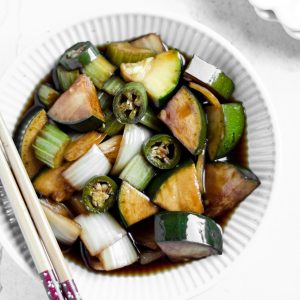
Korean Pickled Vegetables (Jangajji)
Do you want to learn how to make the best Korean Pickled Vegetables (Jangajji) with minimal ingredients, a simple and easy step-by-step process? These vegetables are pickled with just 3 ingredients brine - soy sauce, vinegar, and sugar! It is a perfect balance of sweet, salty, and tangy with crunchy vegetables. This delicious type of side dish (banchan) complements many other dishes in Korean cuisine.
Equipment
2-3 32 ounces Mason jar, more jars for more pickled vegetables
Ingredients
- 2 cups yellow onion sliced in bite-size
- 5 cups zucchini sliced in bite-size
- 1½ cup celery sliced in bite-size
- 4 medium jalapeno sliced in bite-size
- 2 cups soy sauce
- 1 cup vinegar or any type of vinegar
- 1 cup brown sugar
- 2 cups water
Instructions
- Wash and cut the vegetables into bite-size pieces. Use a chopping board and a sharp knife.
- In a saucepan, combine soy sauce, vinegar, water, and brown sugar. You can use granulated sugar as a substitute for brown sugar. Stir and taste the brine solution. You can adjust it to your preference. Bring it to a gentle boil over medium heat. Turn off the heat.
- Add the chopped vegetables into a clean glass jar or container with a lid. Do not overfill the jar.
- Pour the hot brine over the vegetables into the jar. Be sure to submerge all the vegetables to soak all the flavors from the brine.
- Let the veggies pickle overnight at room temperature then you can transfer it into the fridge to chill. It is ready to eat in a few hours after the preparation but the longer it sits in the brine, the more flavorful it is.
Notes
Recipe Notes:
- Choose fresh vegetables with similar textures.
- Pouring the hot brine over the vegetables will lock in a crunchy texture.
- Use glass or ceramic containers for pickling, as these materials do not react to the acidic vinegar. Make sure that the jars are clean and dry before using.
- One way to pre-measure how much brine you will need is to add the chopped vegetables into jars or containers, then add enough water to cover the vegetables. Pour out the water into another jar and check the amount of brine needed. For example, if you pour out around 2 and a half cups of water, you’ll need 1 cup each of water, soy sauce, and half a cup of vinegar for the brine.
- You can use the brine as a dipping sauce for Korean bbq, if you want a bolder taste, simply add more soy sauce as it has a similar taste to a chadol sauce.
Nutrition
Serving: 8servingsCalories: 176kcalCarbohydrates: 37gProtein: 8gFat: 0.4gSaturated Fat: 0.1gPolyunsaturated Fat: 0.1gMonounsaturated Fat: 0.03gSodium: 3273mgPotassium: 447mgFiber: 2gSugar: 31gVitamin A: 285IUVitamin C: 23mgCalcium: 66mgIron: 2mg
Tried this recipe?Let us know how it was!